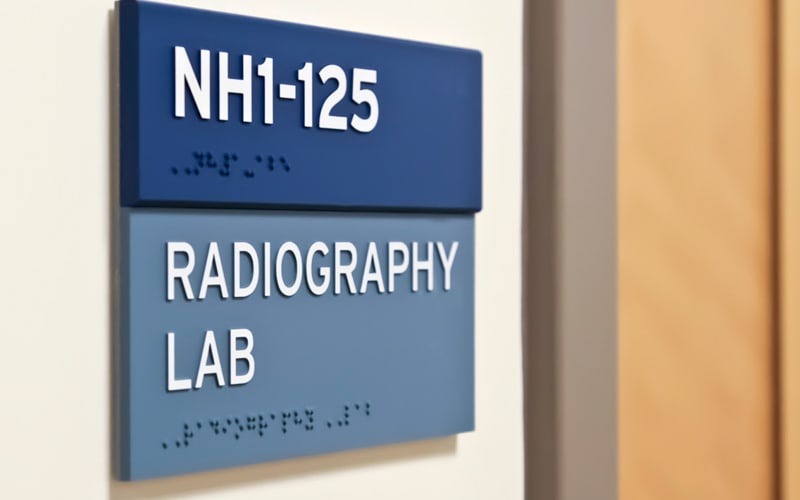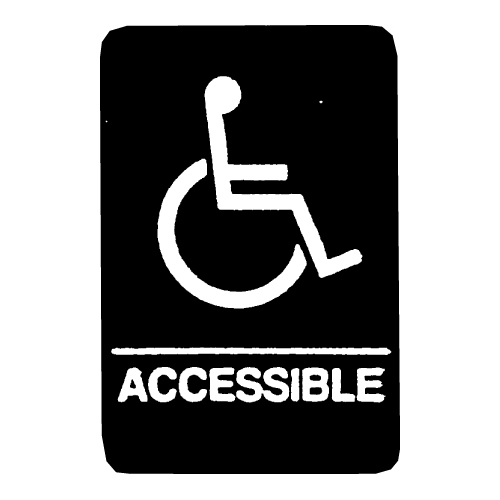ADA Signs: Vital Tools for Inclusive Atmospheres
ADA Signs: Vital Tools for Inclusive Atmospheres
Blog Article
Checking Out the Key Functions of ADA Indicators for Boosted Access
In the world of access, ADA indications act as quiet yet powerful allies, making certain that spaces are accessible and inclusive for individuals with impairments. By incorporating Braille and tactile aspects, these indicators damage barriers for the aesthetically damaged, while high-contrast shade schemes and clear typefaces provide to diverse visual demands. Their calculated positioning is not arbitrary yet rather a calculated effort to help with smooth navigating. Yet, past these features exists a deeper story about the advancement of inclusivity and the continuous dedication to creating fair rooms. What extra could these indicators signify in our quest of global access?
Significance of ADA Compliance
Ensuring compliance with the Americans with Disabilities Act (ADA) is essential for promoting inclusivity and equivalent gain access to in public spaces and work environments. The ADA, enacted in 1990, mandates that all public facilities, companies, and transportation services accommodate individuals with impairments, guaranteeing they enjoy the same rights and chances as others. Conformity with ADA criteria not only fulfills lawful commitments yet additionally improves a company's track record by demonstrating its dedication to diversity and inclusivity.
One of the vital facets of ADA compliance is the application of easily accessible signage. ADA indicators are created to ensure that individuals with handicaps can easily browse via structures and spaces. These indications must follow specific guidelines regarding size, font style, shade comparison, and placement to ensure visibility and readability for all. Properly applied ADA signs assists eliminate barriers that people with specials needs frequently come across, consequently promoting their freedom and self-confidence (ADA Signs).
Furthermore, sticking to ADA regulations can mitigate the danger of potential penalties and legal repercussions. Organizations that fall short to follow ADA standards may encounter penalties or lawsuits, which can be both economically challenging and destructive to their public image. Therefore, ADA compliance is important to promoting an equitable environment for everyone.
Braille and Tactile Components
The unification of Braille and responsive aspects into ADA signage embodies the concepts of ease of access and inclusivity. These functions are important for individuals who are blind or visually damaged, allowing them to browse public spaces with higher self-reliance and confidence. Braille, a tactile writing system, is necessary in providing created info in a style that can be quickly regarded with touch. It is typically put under the equivalent text on signs to make certain that individuals can access the info without aesthetic assistance.
Responsive components prolong beyond Braille and consist of elevated signs and personalities. These components are designed to be noticeable by touch, allowing individuals to recognize space numbers, washrooms, leaves, and various other crucial areas. The ADA establishes particular standards regarding the size, spacing, and placement of these responsive elements to optimize readability and make certain consistency throughout different environments.

High-Contrast Color Design
High-contrast color pattern play an essential function in enhancing the visibility and readability of ADA signs for individuals with visual disabilities. These plans are vital as they maximize the difference in light reflectance in between message and background, making sure that indicators are conveniently noticeable, also from a range. The Americans with Disabilities Act (ADA) mandates the usage of details color contrasts to suit those with minimal vision, making it a critical aspect of compliance.
The effectiveness of high-contrast shades exists in their capability to stand apart in numerous illumination problems, including dimly lit settings and locations with glare. Commonly, dark text on a light history or light text on a dark history is used to accomplish optimum contrast. Black text on a white or yellow background provides a raw aesthetic distinction that helps in quick acknowledgment and understanding.

Legible Fonts and Text Size
When thinking about the design of ADA signage, the option of clear fonts and proper message dimension can not be overemphasized. The Americans with Disabilities Act (ADA) mandates that typefaces have to be not italic and sans-serif, oblique, manuscript, very ornamental, or of unusual form.
The size of the text also plays a critical function in accessibility. According to ADA guidelines, the minimum message elevation should be 5/8 inch, and it ought to boost proportionally with watching distance. This is specifically essential in public rooms where signage demands to be checked out quickly and precisely. Consistency in message dimension contributes to a cohesive visual experience, assisting people in navigating environments successfully.
Additionally, spacing between lines and More about the author letters is essential to readability. Sufficient spacing avoids personalities from showing up crowded, boosting readability. By adhering to these requirements, developers can substantially improve availability, guaranteeing that signs offers its desired function for all individuals, despite their visual capacities.
Reliable Positioning Methods
Strategic positioning of ADA signs is crucial for optimizing accessibility and ensuring conformity with legal requirements. Properly located indicators direct individuals with disabilities effectively, promoting navigating in public areas. Secret factors to consider consist of visibility, height, and proximity. ADA standards stipulate that indicators should be placed at an elevation between 48 to 60 inches from the ground to ensure they are within the line of sight for both Click Here standing and seated individuals. This typical height variety is essential for inclusivity, making it possible for wheelchair users and individuals of varying heights to accessibility info effortlessly.
Additionally, signs need to be put beside the latch side of doors to permit easy recognition before access. This positioning helps people find rooms and rooms without blockage. In situations where there is no door, signs ought to be situated on the nearest surrounding wall surface. Consistency in indication placement throughout a center boosts predictability, minimizing confusion and enhancing general user experience.

Final Thought
ADA indications play an important function in promoting access by incorporating functions that deal with the requirements of individuals with handicaps. These elements jointly foster an inclusive environment, underscoring the relevance of ADA compliance in making sure equal accessibility for all.
In the realm of ease of access, ADA signs serve as quiet yet powerful allies, guaranteeing that rooms are navigable and comprehensive for people with handicaps. The ADA, established in 1990, mandates that all public facilities, companies, and transportation solutions fit people with handicaps, guaranteeing they take pleasure in the same rights and opportunities as others. ADA Signs. ADA indicators are made to guarantee that find out individuals with handicaps can easily navigate via spaces and buildings. ADA guidelines stipulate that signs should be mounted at an elevation in between 48 to 60 inches from the ground to ensure they are within the line of sight for both standing and seated individuals.ADA indicators play an important function in promoting availability by incorporating attributes that attend to the needs of individuals with impairments
Report this page